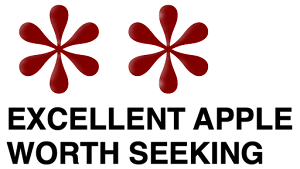 |
I've got three small dark apples to try, classically shaped with a slightly ribbed taper. They are little bigger than crab apples.
The blush runs from a streaky red to a lustrous dark crimson. Unlike some deeply colored apples, the red of this blush has no purple tint.
The unblushed color, visible only in one small patch, is yellow tinted green. Small light lenticels are nearly impossible to see in the darker blush.
King David is solid in hand with a faint sweet cider aroma.
This apple's crisp yellow flesh is crunchy and medium-coarse. Part of one apple has an apricot orange cast to it, perhaps from the blushed peel.King David is quite sweet, with a hint of malt sugar at first that fades to a nutty sweetness, and a fleeting spicy touch. It is almost vinous, but not.
A dollop more tartness might show these flavors in sharper relief, but King David is well balanced. Flavorful, crunchy, and rich, this is a first-rate apple, heady with flavor.
Back Story
This year's apples are courtesy of Steven Edholm, who grew them on his farm near Ukiah, California. Steven sometimes writes about his apples, too.
I enjoyed them very much and am pleased to be able to replace my old review with this one. (The old blog entry remains, and its learned comments are well worth reading if you are interested in this variety.)
Five hundred miles to Steven's south, Kevin Hauser also praises King David on his blog. With these examples in hand it is not hard to see why.
For some speculation on climate and apples, see last year's King David report.
Sources seem to agree that King David is a Jonathon cross but disagree about with what (Winesap and Arkansas Black mentioned as possibilities). Many trace it as far back as Arkansas in the 1890s.


In my opinion King David apples make the best applesauce, hands down. Now, if I could only find a place in Pennsylvania that sold them.
ReplyDelete